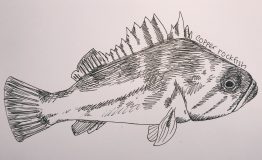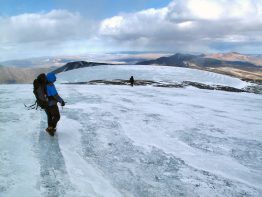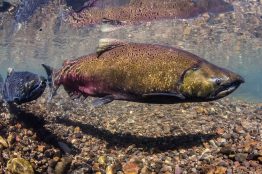If you log into Twitter on a Sunday and search for #SundayFishSketch, you’ll find a plethora of illustrations of fishes and other marine species. They’re submitted by scientists, artists and anyone else inspired to create, from Seattle to Scotland. #SundayFishSketch was created by Rene Martin, a Ph.D. student in the Department of Ecology and Evolutionary Biology at the University of Kansas, in 2016.
Read more »Glaciers in Mongolia's Gobi Desert actually shrank during the last ice age
The simple story says that during the last ice age, temperatures were colder and ice sheets expanded around the planet. That may hold true for most of Europe and North America, but new research from scientists in the Department of Earth and Space Sciences at the UW tells a different story in the high-altitude, desert climates of Mongolia. The recent paper in Quaternary Science Reviews is the first to date ancient glaciers in the high mountains of Mongolia’s Gobi Desert.
Read more at UW Today »Two species of ravens nevermore? New research finds evidence of ‘speciation reversal’
For over a century, speciation — where one species splits into two — has been a central focus of evolutionary research. But a new study almost 20 years in the making suggests “speciation reversal” — where two distinct lineages hybridize and eventually merge into one — can also be extremely important. The paper, appearing March 2 in Nature Communications, provides some of the strongest evidence yet of the phenomenon in two lineages of common ravens.
Read more at UW Today »Largest Chinook salmon disappearing from West Coast
The largest and oldest Chinook salmon — fish also known as “kings” and prized for their exceptional size — have mostly disappeared along the West Coast. That’s the main finding of a new University of Washington-led study published Feb. 27 in the journal Fish and Fisheries. The researchers analyzed nearly 40 years of data from hatchery and wild Chinook populations from California to Alaska, looking broadly at patterns that emerged over the course of four decades and across thousands of miles of coastline.
Read more at UW Today »Three UW Innovation Awards given to UW Environment faculty
College of the Environment faculty received all three of the University of Washington’s Innovation Awards for 2018. The awards are designed to stimulate innovation among faculty from a range of disciplines and to reward some of their most novel ideas, and are made possible by generous donors. Knut Christianson and Michelle Koutnik from the Earth and Space Sciences, along with David Shean from Civil and Environmental Engineering, were awarded $300,000 over two years to “build a digital glacier time machine” that will generate a high-resolution, 3-D time series of how glaciers have changed over time to help understand the future of water resources in the western United States.
Read more at the Office of Research »





